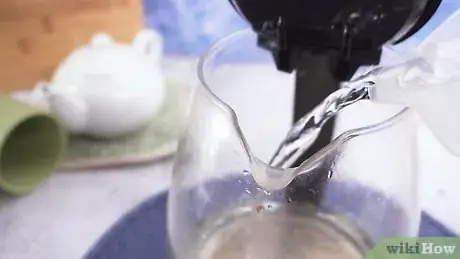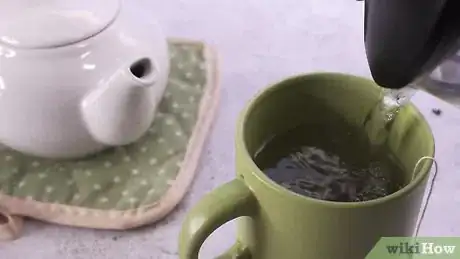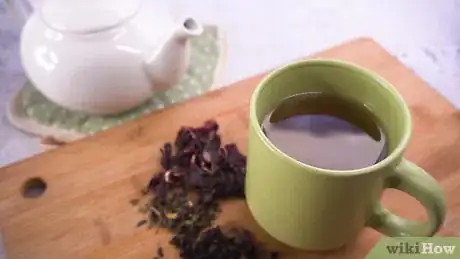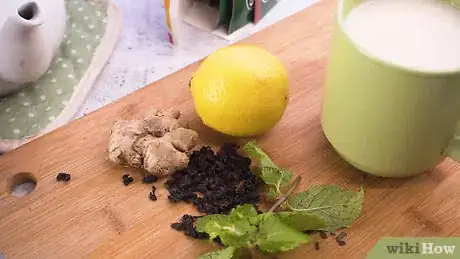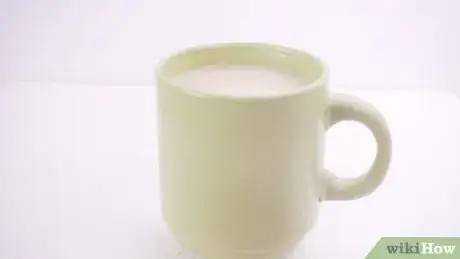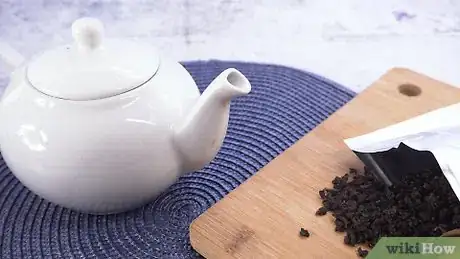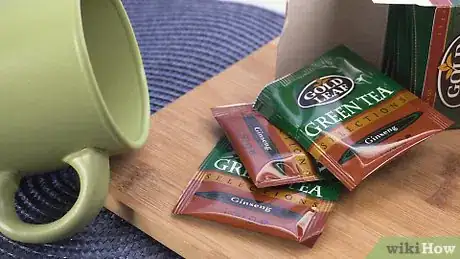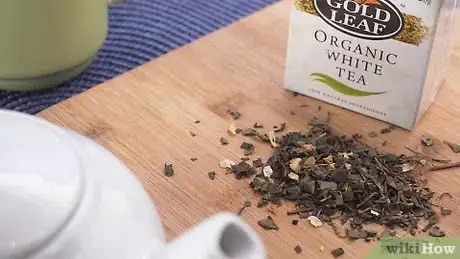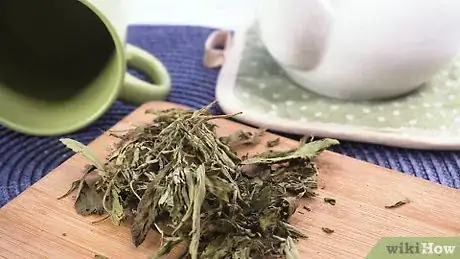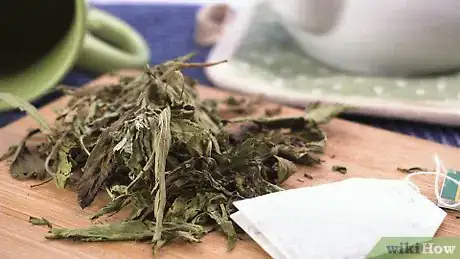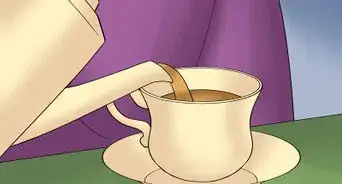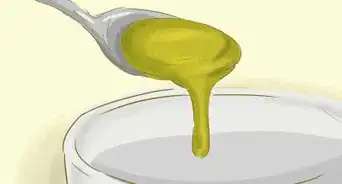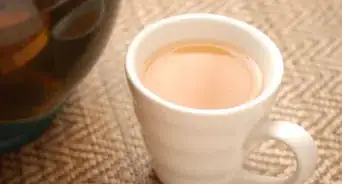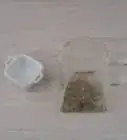This article was co-authored by Julie Brow-Polanco and by wikiHow staff writer, Jessica Gibson. Julie Brow-Polanco is a Master Herbalist & Certified Aromatherapist with more than 11 years of experience. She is an expert on natural remedies and specializes in using them to support whole-body wellness, particularly immune, digestive, nervous, and reproductive health. Julie earned a Bachelor's Degree in Psychology from Dominican University, a Master Herbalist Certification from The School of Natural Healing, and a Certificate of Aromatherapy from the Pacific Institute of Aromatherapy. Julie is a member of the American Herbalist Guild and a Certified Aromatherapist through the National Association of Holistic Aromatherapy.
There are 13 references cited in this article, which can be found at the bottom of the page.
wikiHow marks an article as reader-approved once it receives enough positive feedback. This article has 12 testimonials from our readers, earning it our reader-approved status.
This article has been viewed 2,030,219 times.
A well-made cup of hot tea can warm the heart and soul of any tea lover, but it can be unpleasantly bitter or disappointingly tasteless when improperly steeped. Fortunately, it's easy to prepare a tasty cup of tea. Decide what type of tea you want to brew and choose loose leaves or tea bags. Then heat your water and pour it over the tea. Let the tea steep for the right amount of time according to the tea type and then remove the tea. Enjoy your hot tea on its own or with milk and sugar.
Steps
Heating the Water
-
1Put fresh water into a kettle. If you're just making a cup of tea, pour about 1 1/2 times as much water as you need to fill the cup. If you're making a pot of tea, fill the kettle. This will allow for some of the water to evaporate. For the best-tasting tea, use water that hasn't been boiled before.
- Use a stovetop kettle that will whistle when the water boils or turn on an electric tea kettle that will turn off automatically once the water boils.
Variation: If you don't have a kettle, pour the water into a saucepan. Heat the water over high heat until it's as hot as you need.
-
2Heat the water according to your tea type. Since the water that's too hot can damage delicate tea, it's important to heat the water based on what kind of tea you're making. You can use a thermometer or pay attention to the water so you know when to turn off the heat. Heat the water according to these types:[1]
- White teas: 165 °F (74 °C) or once the water becomes hot to the touch
- Green teas: 170 to 185 °F (77 to 85 °C) or just when steam begins to come out of the spout
- Black teas: 205 °F (96 °C) or after cooling boiling water for 1 minute
Advertisement -
3Microwave water in a mug if you don't have access to a kettle or stove. Although your water will heat more evenly in a kettle or pot on the stove, you can fill a microwave-safe mug about 3/4 full with water and place a wooden skewer or popsicle stick into it. Microwave the water for 1 minute or until the water begins to bubble.[2]
- The wooden skewer will prevent the water from superheating which could cause an explosion.
-
4Pour a little water into the teapot or cup to preheat it. If you pour hot water into a cold teapot or cup, the water temperature will drop dramatically and your tea won't steep properly. To preheat the vessel, fill the teapot or cup about 1/4 to 1/2 full with some of the hot water. Leave it for about 30 seconds and then pour it out.[3]
- If you're in a hurry you can skip this step, but your tea will be hotter and taste better if you preheat the vessel.
Steeping the Tea
-
1Place tea leaves or bags into the teapot or cup. If you're using tea bags, plan on using 1 bag for each cup of tea you want to make in a teapot or put 1 bag into 1 cup. To use loose leaf tea, plan on using about 1 tablespoon (2 g) of loose leaves for each cup of tea you want to make.[4]
- If you like your tea stronger, feel free to use more leaves.
-
2Pour the hot water over the tea. Carefully pour the water into your kettle or cup. If you're using a cup, fill it about 3/4 full so you'll have room to add milk later. If you're making loose leaf tea in a teapot, pour about 3⁄4 cup (180 ml) of water for each serving of tea. For tea bags in a teapot, pour around 1 cup (240 ml) of water for each tea bag.
- If you're making loose leaf tea in a cup, consider putting the tea into a mesh tea ball or place a strainer into the cup before you add the tea and water. Then you can lift up the strainer or ball to remove the tea leaves.
- Consider measuring the water the first few times you use the teapot. Then you can begin to eyeball how much water to use once you're comfortable with the teapot.
-
3Steep the tea according to tea type. If you use loose leaves, you'll see them unroll and expand as they steep. If you use tea bags, you'll see the water begin to change color, unless you're brewing white tea. Leave the tea to steep for:[5]
- 1 to 3 minutes for green tea
- 2 to 5 minutes for white tea
- 2 to 3 minutes for oolong tea
- 4 minutes for black tea
- 3 to 6 minutes for herbal tea
Did You Know? The longer you steep your tea, the stronger the flavor will be. Use a spoon to taste the tea so you don't over steep it, which could cause the tea to taste bitter.
-
4Strain the tea leaves or remove the tea bags. If you used tea bags, lift them up and let excess tea drip back into the cup or teapot. If you used loose leaf tea, remove the tea ball or place a strainer over a cup and pour the tea through it. Save the tea leaves for another brew or discard them.
- Compost your tea bags or leaves once you've finished making tea.
Serving the Tea
-
1Drink the hot tea on its own to highlight its distinctive taste. If you'd really like to taste the tea itself, don't add sugar, milk, or lemon. This is especially important if you're drinking white, green, or herbal tea since milk can overwhelm the tea's delicate flavor.
- Lower-quality teas that are often sold in tea bags might benefit from additional sweetener or milk.
-
2Add milk to black tea for a creamy taste. Traditionally, milk is only added to black teas, such as breakfast tea. Since there's no wrong or right way to drink tea with milk, pour the milk into the cup first or after you've poured the tea. Then stir gently and place your spoon on the saucer next to the cup.[6]
- Although you may hear people ask if you take cream, avoid using heavy cream or half-and-half in your tea. The high-fat content will create a heavy taste that masks the flavor of the tea.
-
3Stir in honey or sugar to sweeten the tea. If you don't like the taste of tea on its own, add a little granulated sugar, honey, or your favorite sweetener. For example, sweeten your tea with stevia, agave syrup, or flavored syrup, such as vanilla syrup.[7]
- Masala chai is typically sweetened with granulated or brown sugar.
- Honey is a great choice to sweeten green or white teas.
-
4Include lemon, ginger, or mint if you'd like to give the tea a bright flavor. Try squirting a little freshly sliced lemon into your tea or adding a few sprigs of fresh mint. If you'd like to add a slightly spicy flavor, add a thin slice of fresh ginger to the tea.[8]
- For a festive way to flavor bold teas, add a short cinnamon stick directly to the teacup.
Tip: Since citrus can cause milk to curdle, avoid adding lemon to tea if you're also adding milk.
-
5Chill the tea to make iced tea. If you'd rather be drinking cold tea, put your tea in the refrigerator and leave it until it's completely cold. Then fill a glass with ice and pour the cold tea into it. Enjoy the iced tea before the ice melts.
- You can make iced tea out of any type of tea. Try making iced sweet tea with black tea or an iced herbal hibiscus tea.
Selecting Tea to Brew
-
1Pick black tea for a bold beverage that stands up to milk or sweetener. For a smoky, black tea, look for Lapsang Souchong. If you want a strong, malty flavor, buy Assam. If you plan on drinking tea with milk or sugar, consider using a breakfast or everyday blend.[9]
- Look for flavored black teas, such as Earl Grey, Lady Grey, or masala chai to include a floral, citrus, or spicy taste.
-
2Pick green tea for a light, earthy flavor. Green tea has less caffeine than black tea and has a more delicate flavor. This can be a great option to stay hydrated and can be enjoyed either hot or cold. If you prefer to drink tea without milk or sweetener, try a green tea so you can detect its subtle flavor.[10]
- If you're interested in green tea, learn how to make matcha. Matcha is stone-ground green tea that's traditionally used in Japanese tea ceremonies.
Tip: If you enjoy black and green teas, try oolong tea. This type of tea is oxidized like black tea, but not as processed so it keeps some of its grassy flavors.
-
3Select white tea for mild flavor and a little caffeine. White tea is the least oxidized and contains very little caffeine. Choose this tea if you like a smooth tea that's easy to drink without adding sweeteners or flavors.[11]
- Because it's so minimally processed, you can usually only buy white tea as loose leaf instead of in bags.
-
4Look for herbal tea if you want to avoid caffeine. If you're watching your caffeine or just want to try a delicate tasting tea, pick a few herbal teas to try. Classic peppermint tea is refreshing hot or cold and chamomile tea is known for its soothing quality.[12]
- Rooibos is another popular herbal tea that's often blended with dried fruit or vanilla.
- To make chamomile tea, use fresh, washed chamomile leaves, chopped up. Use 1 equal tablespoon of chopped chamomile leaves for 1 8-ounce cup of tea. Add to hot water then steep, covered, for about 5-10 minutes. If left longer, it becomes medicinal but also tastes stronger. Strain and serve.
-
5Choose between loose leaves or tea bags. If you'd like to use high-quality tea leaves that you can steep multiple times, use loose leaf tea. These are uncut and dried when you buy them, although they'll unwrap and expand as they steep. For a convenient way to make tea, buy tea that's been cut and portioned into bags. Unfortunately, you can only steep these once.[13]
- For high-quality tea bags, choose pyramid style bags that allow the tea to expand as it steeps. If you can't find these, look for round tea bags that are filled with finely-cut tea.
Did You Know? The most popular type of tea bag is square with a string and tag. Although these are easy to find, they're usually filled with lower-quality, shredded tea and powder.
Community Q&A
-
QuestionHow can I make tea using condensed milk?
 Community AnswerThe instructions for making tea made with condensed milk can be found in some of our other wikiHow articles. For example, see How to Make Milk Tea.
Community AnswerThe instructions for making tea made with condensed milk can be found in some of our other wikiHow articles. For example, see How to Make Milk Tea. -
QuestionWhat causes the brown scum inside the cup after filling the cup with tea?
 Community AnswerThe brown scum is the remains of the colors of the leaves. This means that your tea is fresh and in great condition. To get rid of it, just wash the cup well with dish soap.
Community AnswerThe brown scum is the remains of the colors of the leaves. This means that your tea is fresh and in great condition. To get rid of it, just wash the cup well with dish soap. -
QuestionHow can I enjoy tea without burning my tongue?
 Community AnswerTea can scald if you drink it while it is too hot. Always allow the tea to cool a little before taking your first sip, so that it won't be scalding hot. Another option is to pour in a little amount of cold water but this should only be done if you need to drink the tea quickly, or if the tea is too strong, as it waters down the tea flavor.
Community AnswerTea can scald if you drink it while it is too hot. Always allow the tea to cool a little before taking your first sip, so that it won't be scalding hot. Another option is to pour in a little amount of cold water but this should only be done if you need to drink the tea quickly, or if the tea is too strong, as it waters down the tea flavor.
Warnings
- Always use caution when boiling and pouring the water since it can splash and burn you.⧼thumbs_response⧽
Things You'll Need
- Measuring spoon or digital scale
- Teapot
- Teacups
- Timer
- Spoon
- Strainer, optional
References
- ↑ https://www.gayot.com/drink/tea/best-temperatures-for-brewing-tea/
- ↑ http://www.animations.physics.unsw.edu.au/jw/superheating.htm
- ↑ https://www.ohhowcivilized.com/how-to-correctly-brew-a-cup-of-tea/
- ↑ https://youtu.be/5PgfhDSqIto?t=11
- ↑ https://youtu.be/629XWk2PctQ?t=165
- ↑ https://www.theguardian.com/science/brain-flapping/2014/oct/03/how-to-make-tea-science-milk-first
- ↑ https://www.foodnetwork.com/healthyeats/recipes/2011/06/iced-tea-cutting-the-sugar
- ↑ https://www.foodnetwork.com/recipes/photos/11-ways-to-flavor-plain-iced-tea
- ↑ https://youtu.be/YxSjcFMVZXA?t=86
About This Article
To make tea from tea leaves, start by placing the leaves in an infuser or strainer. Once filled, place the tea strainer in a mug or teapot, then pour boiling water over it. Typically, you want about one to three teaspoons of leaves for every 8 to 12 ounces of water, depending on your preference for the strength and taste of your tea. Next, allow the tea to steep -- a good rule of thumb is 2 minutes for green tea, 4 minutes for black tea, and 5 minutes for herbal tea. Once your tea is ready, remove the strainer and serve, adding lemon, milk and sugar as desired. For an even easier cup of tea, you can just use a teabag and pour boiling water directly over. Then, let your tea steep until it is ready. For more tips, including when to add milk, read on!
